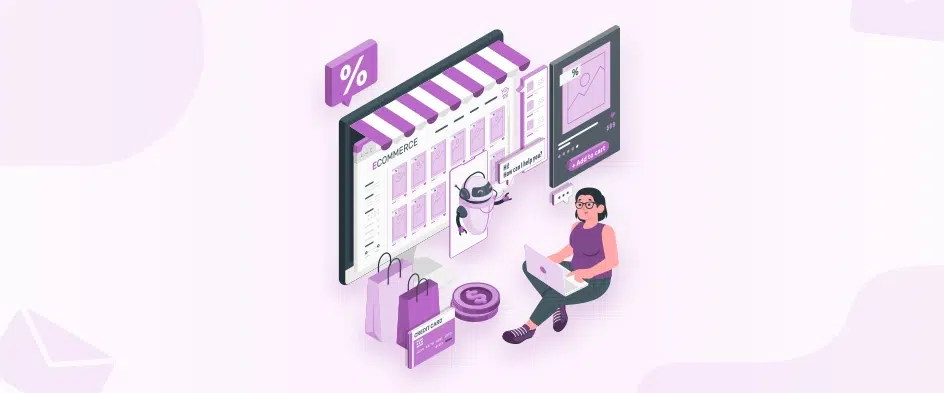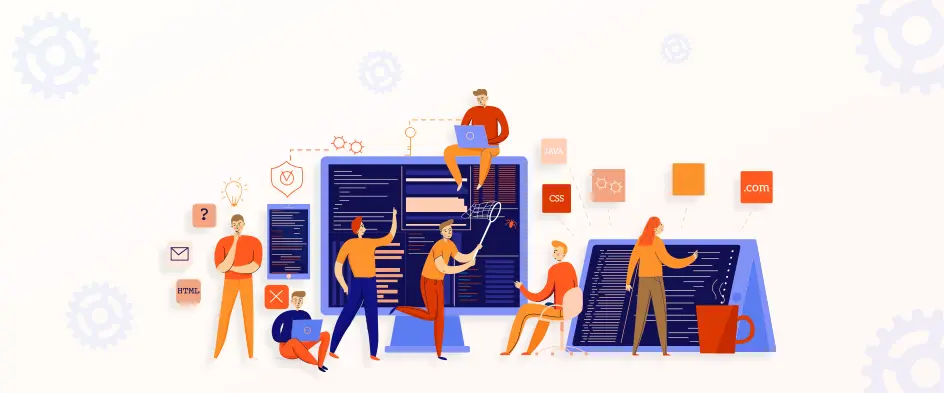7 eCommerce Development Trends to Watch

- 9 Minutes to read
Table of Content
- What is eCommerce Development?
- Popular eCommerce Development Trends
- What are the Benefits of eCommerce Development Trends?
- Summary
- FAQs on eCommerce Development Trends
Around the world, there are more than 26 million eCommerce websites, and that shows the competition. So, if you want to stand out from the crowd, you will need two things.
One, you can hire the top eCommerce development companies to help you create the best eStore possible. And two, you can opt for the popular eCommerce development trends that will make you stand out and be captivating to the target audience. Some of these trends include mobile commerce, personalization, AI and ML, voice commerce, and more.
I have compiled this blog to explain these trends a little further, along with how they impact the future of your website. So, let’s begin.
What is eCommerce Development?
eCommerce development is all about making and improving online platforms for buying and selling goods or services. It involves designing, developing, and maintaining websites or mobile apps as a means to carry out transactions between businesses and customers.
The purpose of eCommerce development is to facilitate the buying and selling of products and services online without even leaving your house. For businesses, it’s all about a wider customer base, increased sales, and an improved customer experience.
eCommerce is always evolving. Companies are always looking to integrate AI, virtual reality, and voice recognition into their platforms to provide better user experience and make shopping easier.
Popular eCommerce Development Trends
eCommerce development has been continuously evolving, and it is essential to stay on top of the latest trends to stay competitive in the online marketplace. Here are four key insights into the evolution of eCommerce development:
1. Mobile Commerce
M-Commerce is the buying and selling of goods and services online using a mobile device, such as a smartphone or tablet. Just a few taps on a phone, and you can buy products and services anywhere, anytime. It’s transformed the retail landscape.
Accessibility is key. Consumers can get online stores through apps or websites. This makes it easier for businesses to reach the growing market of smartphone users. Mobile payments have also taken off. With digital wallets like Google Pay, customers can securely store payment info and complete purchases with a touch or scan. It streamlines checkout and boosts security.
Personalization matters, too. Businesses use analytics to understand customer preferences and behavior. This helps them tailor the shopping experience, building loyalty and boosting sales.
The convenience of this trend has made it incredibly popular, with global mobile commerce sales reaching $2.2 Trillion in 2023. That makes up for 60% of all eCommerce sales worldwide.
2. AI and Personalization
AI and ML are being used in eCommerce in a variety of ways, including to personalize the shopping experience, improve product recommendations, and detect fraud. Companies use advanced tech and data analysis to meet the needs of their customers. They understand their unique characteristics and tailor their offerings and marketing strategies.
Each customer has different preferences and purchase history. That means companies can create targeted promotions and recommendations for individual customers.
However, personalized customer experiences go beyond product recommendations. Businesses use features like personalized greetings, customized landing pages, and tailored email campaigns to engage customers. By recognizing returning customers and addressing them by name, loyalty and trust can be fostered.
3. Omnichannel Integration
To provide a seamless shopping experience, eCommerce platforms are integrating various channels such as websites, mobile apps, social media, and physical stores. Customers can browse, purchase, and return products across different channels, ensuring convenience and flexibility.
Improved customer experience: Omnichannel integration makes it easier for customers to shop with a business, regardless of the channel they choose. Customers can start shopping on one channel and finish on another without having to worry about losing their shopping cart or having to enter their information multiple times.
Increased sales: Omnichannel integration can lead to increased sales by making it easier for customers to find and purchase the products they want. For example, a customer might see a product on a social media platform, then go to the website to learn more about it, and finally purchase it in a brick-and-mortar store.
Reduced costs: Omnichannel integration can help to reduce costs by streamlining operations and eliminating inefficiencies. For example, a business can use a single inventory management system to track inventory levels across all channels.
So, how do you reap the benefits of omni-channel integration?
- Use a unified commerce platform: A unified commerce platform is a software solution that integrates all of a business’s sales channels into a single system. This makes it easier for businesses to manage their inventory, orders, and customer data across all channels.
- Use APIs: APIs (application programming interfaces) allow businesses to connect their different sales channels together. This will enable them to share data and functionality between channels.
- Use third-party solutions: There are a number of third-party solutions that can help businesses to integrate their sales channels. These solutions can provide a variety of features, such as unified inventory management, order fulfillment, and customer support.
When choosing an omnichannel integration solution, it is important to consider the specific needs of the business. Businesses should also consider the cost and complexity of the solution, as well as the ease of implementation.
By integrating their sales channels, eCommerce businesses can create a seamless and convenient shopping experience for their customers. This can lead to increased sales, reduced costs, and improved customer loyalty.
4. Voice Search
Voice search is a type of search that allows users to perform searches using spoken language instead of typed text. Voice search is becoming increasingly popular, as it is a convenient and hands-free way to search for information.
This eCommerce trend allows customers to search for products and make purchases without having to type anything. That is especially convenient for customers who are shopping on mobile devices or who are busy with other tasks.
Here are a few tips to optimize your eCommerce website for voice search:
- Use long-tail keywords: Long-tail keywords are more specific and conversational than short-tail keywords.
- Use natural language: When writing product descriptions and other content for your website, use natural language that is similar to the way people speak. That will make it easier for voice search engines to understand your content.
- Optimize for local search: Voice search is often used for local searches, such as “restaurants near me.” Make sure that your website is optimized for local search by including your business name, address, and phone number on every page.
- Structure your website logically: Voice search engines use the structure of your website to understand the content on each page. Make sure that your website is well-structured and that your product pages are easy to navigate.
- Use rich snippets: Rich snippets are additional bits of information that can be displayed in search results.
In addition to optimizing their websites and products for voice search, eCommerce businesses can also develop voice-enabled shopping experiences. It allows customers to search for products and make purchases using voice commands.
Voice-enabled shopping experiences can be developed using a variety of tools and platforms, such as Amazon Alexa, Google Assistant, and Siri. By developing voice-enabled shopping experiences, eCommerce businesses can make it even easier for customers to shop with them.
Did you know? The global transactions through voice commerce are expected to reach over $20 Billion by 2023. The main reason behind that is that voice commerce is faster than traditional browsing and clicking. On top of that, the accuracy and security measures will continue to get better.
5. Social Commerce
Social commerce is the buying and selling of goods and services directly through social media platforms. This trend is growing rapidly as more and more consumers are spending time on social media.
It allows businesses to reach potential customers where they are already spending their time, and it allows consumers to shop conveniently and without having to leave their favorite social media platforms.
You have a number of ways to participate in social commerce for your eStore business. A few common ones include:
- Selling products on social media platforms: Many social media platforms now allow businesses to sell products directly on their platform. For example, businesses can create product listings on Facebook Marketplace or Instagram Shopping.
- Using social media marketing to drive traffic to their eCommerce website: Businesses can use social media marketing to promote their products and drive traffic to their eCommerce website. For example, businesses can create social media posts and ads that feature their products and include links to their website.
- Partnering with social media influencers: Social media influencers are people who have a large and engaged following on social media. Businesses can partner with social media influencers to promote their products to their followers.
Social commerce is a growing trend that eCommerce businesses should not ignore. By participating in this trend, eCommerce businesses can reach new customers, increase customer engagement, and boost sales.
6. Augmented Reality and Virtual Reality
Augmented reality (AR) and virtual reality (VR) are two emerging technologies that are having a major impact on the e-commerce industry. AR overlays digital information onto the real world, while VR creates a fully immersive virtual environment. Both technologies can be used to improve the customer experience and increase sales.
A few ways the top eCommerce agencies incorporate AR and VR in your eStore are:
- Virtual try-on: AR can be used to allow customers to try on products virtually before they buy them. It is especially useful for products like glasses, clothing, and furniture.
- Product visualization: AR can also be used to give customers a better understanding of how products will look and function in their own environment. For example, customers can use AR to see how a new sofa will fit in their living room or how a new paint color will look on their walls.
- Interactive shopping experiences: AR and VR can be used to create interactive shopping experiences that are more engaging and informative than traditional shopping methods. For example, customers can use VR to explore a virtual store or use AR to interact with products in a real-world setting.
These strategies will help improve the customer experience, increase sales, and reduce costs. And as this technology continues to develop, these attributes will proliferate even further.
7. AI Chatbots
AI chatbots are computer programs that can simulate conversations with humans. They can be used to answer customer questions, provide support, and even make sales. They ensure you get the best support in as little time as possible. Here’s how the top eStore development services opt to use AI chatbots in the websites.
- Customer service: AI chatbots can be used to provide 24/7 customer support. This is especially useful for small businesses that may not have the resources to hire a human customer service team.
- Sales support: AI chatbots can be used to help customers find the products they are looking for and answer their questions about products and services. This can lead to an increase in sales.
- Personalization: AI chatbots can be used to personalize the customer experience. For example, an AI chatbot can remember a customer’s past purchases and recommend similar products. It can help customers to find the products they are most likely to be interested in.
As the technology becomes more sophisticated, AI chatbots will be able to provide even more personalized and helpful customer service.
If you want to incorporate these popular eCommerce trends into your store website, pick from the top web development companies and go for it. They can have a lot of benefits, and we’ll see some of them in the next section.
What are the Benefits of eCommerce Development Trends?
So far, I have shown you the best trends that can take your eCommerce store to the stratosphere. That’s why well-recognized eStore development companies opt for trends like personalization, AI chatbots, mobile commerce, social commerce, AR and VR, and more on online store customizations.
The benefits of eCommerce development trends are numerous, including:
- Improved customer experience: The eCommerce development trends can help to improve the customer experience in a number of ways. For example, AR and VR can provide customers with a more immersive and engaging shopping experience. In contrast, AI chatbots can provide customers with 24/7 support and help them to find the products they are looking for more easily.
- Increased sales: eCommerce development trends can also help to increase sales. For example, AR and VR can help customers to make more informed purchase decisions, while AI chatbots can help to personalize the customer experience and increase conversions.
- Reduced costs: eCommerce development trends can also help to reduce costs in a number of ways. For example, AR and VR can be used to create virtual product catalogs, which can save retailers the cost of printing and shipping physical catalogs. Additionally, AI chatbots can help to reduce customer service costs.
- Competitive advantage: eCommerce businesses that adopt the latest development trends can gain a competitive advantage over their competitors. That is because customers are more likely to shop with businesses that offer a superior shopping experience.
Overall, the benefits are immense. By adopting the latest trends, eCommerce businesses can improve the customer experience, increase sales, reduce costs, and gain a competitive advantage. That will help make your store the best in the business.
Summary
If you keep up with the eCommerce industry, I’m sure you already know how fierce the competition is. So you need to stay updated with the popular eCommerce development trends to get an undeniable edge over the competitors. Here are a few:
- Personalized shopping experiences
- Mobile Optimization
- AI/Chatbot Integration
- Blockchain technology
- Voice Search
- Virtual Reality
- Social Commerce
If you want help with these eCommerce development trends for your website, our experts will suggest the best companies for the same.
FAQs on eCommerce Development Trends
What are the latest trends in eCommerce development?
1. Some of the latest trends in eCommerce development include,
- Mobile Optimization
- Voice commerce
- AI and ML integration
- Personalized shopping experiences
- AR Applications.
2. Why is mobile optimization important in eCommerce development?
Mobile optimization is crucial in eCommerce development because an increasing number of consumers prefer to shop on their mobile devices. It ensures that online stores are visually appealing, easy to navigate, and fast-loading on smartphones and tablets.
The seamless mobile experience ultimately leads to enhanced user engagement, higher conversion rates, and improved customer satisfaction.
3. How can AI and machine learning benefit eCommerce development?
AI and machine learning can greatly benefit eCommerce development by enabling personalized product recommendations, chatbots for customer support, fraud detection, inventory management, and dynamic pricing. These technologies enhance the overall customer experience, automate processes, and help businesses make data-driven decisions to optimize their operations.



